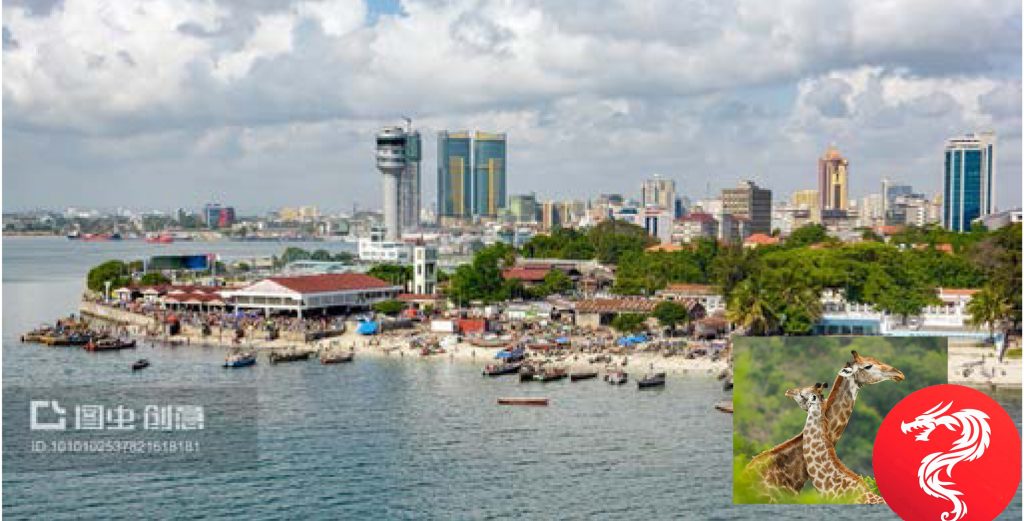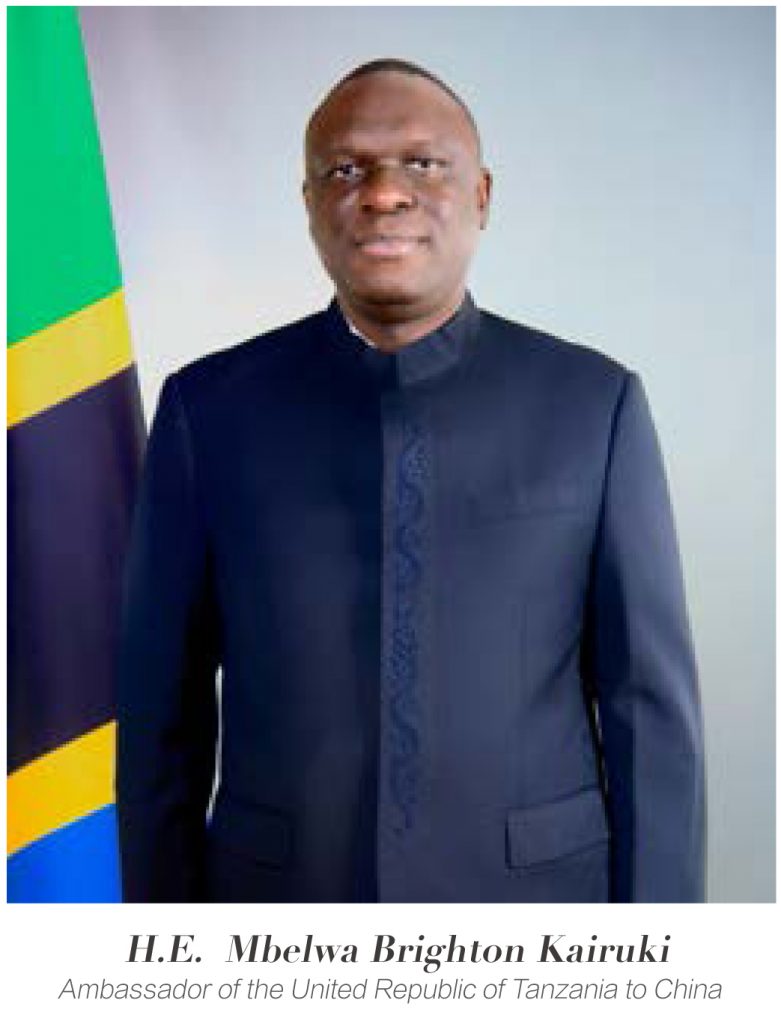——in Honor of the 60th Anniversary of the Independence of Mainland Tanzania, and the 57th Anniversary of Diplomatic Relations With Beijing

By H.E. Mbelwa Brighton Kairuki, Ambassador of the United Republic of Tanzania to China
The Ever Flourishing Relationship between China and Tanzania
On 9th December 2021, Tanzania celebrated the 60th anniversary of the Independence of Tanzania Mainland (formerly known as Tanganyika). It is also the year when China and Tanzania celebrated the 57th anniversary of diplomatic relations.
The ever flourishing relationship between the two countries dates back to generations of the founders of the two nations, namely Mwalimu Julius Kambarage Nyerere and Abeid Amani Karume of the United Republic of Tanzania and Chairman Mao Zedong and Premier Zhou Enlai of the People’s Republic of China. This friendship has solidified and withstood several economic tremors that have faced and continue to face the world in general and the two countries in particular.
Despite the changes in global economic landscape, China has remained a steadfast and dependable friend and development partner to Tanzania and the Tanzanian people, thanks to the continued exemplary leadership of Their Excellencies President Xi-Jinping of China and President Samia Suluhu Hassan of Tanzania. Over the years, China has contributed substantially towards the attainment of Tanzania’s economic and development goals.
For instance from 1969 to 1974, China built the Tanzania-Zambia Railway, famously known by its acronym TAZARA. Around the same time, China built many factories in Tanzania, including the Tanzania – China Textile Friendship Mill, famously known as URAFIKI (friendship), which at the time of its launching, was the largest fully-integrated textile mill in East Africa.

Today, the Chinese investment footprint remains visible and growing in Tanzania and Africa at large.
In Tanzania, it encompasses many sectors, such as agriculture, fisheries, industries, infrastructure development and others. With over 700 projects, employing over 87,000 locals and valued at almost USD 7 billion, China is currently the leading investor in Tanzania.
But the footprint is not limited to trade and investment.
Tanzania has been benefiting from Chinese grants, concessional and commercial loans as well as technology and expertise. These facilities have enabled Tanzania to construct important infrastructure, such as the National ICT Broadband network, the Dar es Salaam – Mtwara Gas Pipeline, the new University of Dar es Salaam Library, Kagera Vocational College and many other projects.
China is promoting the Belt and Road Initiative, which seeks to enable partners such as Tanzania to overcome economic and development challenges, through better policy coordination, connectivity, trade and investment, financial integration and promotion of people-to-people relations, which Tanzania and China have been doing most effectively, since the establishment of bilateral relations in 1964. After being cautioned about Chinese intentions in relation with Africa and Tanzania in particular, Mwalimu Nyerere responded: “…we shall see for ourselves what are China’s intentions towards us. We shall not be told by others.”
After more than 55 years of friendship and cooperation with China, Tanzania is more than certain about China’s intentions towards Tanzania and other developing countries. In the words of President Xi, China wishes “to build a community with a shared future.” Tanzania stands ready as always to work with the Government and people of China to build a shared prosperous future for all our peoples.
Investment opportunities in the Gemstone Mining Sector of Tanzania
In the spirit of this friendship and partnership, in the milieu of the implementation of the Chinese Belt and Road Initiative (BRI) as well as the outcome of the 8th Ministerial Meeting of the Forum on China-Africa Cooperation (FOCAC) that was recently held in Dakar Senegal, the Embassy of Tanzania promoted Tanzania Gemstone Industry at the 1st International Gemstones and Diamond Trade Summit in Macau on 10 December, 2021.
The goal is to promote and attract investment in gemstone mining sector in Tanzania. The Chinese investors are welcome to explore investment opportunities in the mining sector in Tanzania, including extraction, beneficiation and other value added activities of metallic minerals such as gold, silver, iron, copper, platinum, nickel, tin, lead and manganese; industrial minerals such as graphite, kaolin, phosphate, lime, gypsum, diatomite, bentonite and vermiculite; gemstones such as Tanzanite, diamonds, ruby, garnet, sapphire, tourmaline and alexandrite; and energy minerals such as coal and uranium. Investment is also welcome in the provision of mining services, equipment and materials to large scale as well as small and medium scale
miners.
Opportunities for partnerships and collaborations with the public and private enterprises and individuals in Tanzania are also available.
The prospective investors stand to benefit from fiscal and nonfiscal incentives in the mining sector. They are also assured of a safe and secure environment to pursue their investment in a peaceful and tranquil environment, in a country that is a leading investment destination in Africa.
The Gems and Jewelry Industry of Tanzania
Tanzania is endowed with quality gemstones found in various geological settings including spinel, amethyst, aquamarine, emerald, garnet, ruby, tourmaline and sapphire among others. Tanzania host the economically important and unique Mirerani Tanzanite gem deposit. Tanzanite is one of the rare precious gemstones that is found only in Tanzania. Due to its peculiarity and importance, the Government of Tanzania decided to declare Mirerani as a Mining-Controlled Area so as to combat mineral smuggling.
Following the mining reforms and political will showed by the 5th phase Government, the Control Wall with a perimeter of 24.5 km, surrounding the Mirerani mining area was constructed. Following this initiative, there has been an incredible increase inTanzanite production compared to the years before. Tanzanite production from Small-Scale and Medium-Scale mines (covering the periods of 2015/16 – 2020/21) increased from
156.15 kg (2016/17), 464.45 kg (2017/18) to 1,964.75 kg (2018/19), 4,642.49 kg (2019/20) and 8,962.24 kg (2020/21).

Note that the production reported in 2015/16 includes production from both Small-Scale miners and Tanzanite One Mining Limited (the major producing mine in Block C has not been operating since 2017).
On the other hand, Tanzania has been a significant natural rough diamond producer for several decades, with the bulk of production coming from the Williamson Diamond Limited (WDL) Mine at Mwadui (large scale producer), El-Hillal Minerals Limited (medium scale producer) and other small-scale producers. Over 300 kimberlites are known in Tanzania of which, 20% are diamondiferous.
WDL is famous for its production of exclusive pink diamonds of which among others a 23.16 carats pink produced in 2015; 32.33 carats pink produced in 2016, 19.36 carats pink produced in 2018, and and 21.18 carats pinks produced in 2019. In formalizing the mining sector, Tanzania has succeeded in establishing Mineral Markets in various regions within the country. With this experience Tanzania has been able to put in place a very good network of value chain system that oversees the interests of the seller, buyer and Government.
The Gemstone and Jewelry Market Size of Tanzania
The study by Robert Grafen (November, 2015) shows that the remaining Tanzanite resources within Block C are between 1,759,102 tons and 1,469,743 tons with total carats contained between 72,752,292 and 87,103,683. Therefore, Robert estimated the lifetime of the mine to be 27 years by considering the mining rate of 54,000 tons per annum. In his remarks, he concluded that tanzanite resource at Block C is estimated to be 2/3 of total resource at Mirerani. Therefore, the approximate resource of tanzanite in other remained Blocks is 1/3.
Tanzanite with the reputation of being the most beautiful stone discovered in the last 2000 years and with more affordable option, has investment potential due to the following facts: (a) It is a pleochroic gemstone, meaning that it can display different colours when viewed at different angles, the blue and violet. Vivid Intense blue is the best and most valuable tanzanite colour; (b) It’s rare because is found in only one region of Tanzania and is about 1000 times rarer than diamonds!
The natural stores of tanzanite are depleting and are estimated to run out in the next few decades. This is why the stone is called a ‘geological phenomenon’ as the chances of another tanzanite mine being found are roughly 1 million to 1. Numerous sellers of tanzanite use the fact that tanzanite is only found in one small area to promote the material’s rarity; (c) It is also suggested that the value of tanzanite will skyrocket when the known deposits are mined out. That might occur initially. No one knows for sure.
China Diamond and Gemstone Exchange (Macau)
China Diamond and Gemstone Exchange (Macau) is willing to provide the one stop service for the mining companies, gemstones traders and jewellers from Tanzania. China Diamond and Gemstone Exchange Macau is willing to share its own resource to work with Embassy as the exclusive service provider for the dealers from
Tanzania. Our embassy in China is also willing to facilitate this process.
Tanzanian gemstones dealers are interested in finding direct markets for both rough and polished goods. Potential buyers are welcome to be linked with dealers through the China Diamond and Gemstone Exchange and visit Tanzania’s mineral markets where they can easily link with dealers who don’t have yet access to the Chinese market. On the other hand, gemstones producers are interested to be linked with the investors who are willing to invest in partnerships in various areas of potential gemstones production. The investments could directly be in mining operations, exports of gemstones or equipment supply.
The Control of the Production and Marketing of
Tanzanite Jewelries
Under the special diplomatic relationship between two countries, the exchange will provide exclusive promotion and auctionopportunities to Tanzania under the guidance of the Embassy totarget the correct markets. Tanzania needs exclusive promotion ofTanzanite in the Chinese market. One of the major factors in themarketing of jewelry products such as Tanzanite Jewelries is howthe control of the production and marketing of these gemstonesis carried out to the end consumer.
Another criterion used is to encourage the purchase of gemstones such as Tanzanite and convince the consumers that the money they spend, contributes to improving the lives of other people apart from the prestige they get.
Strategies that Tanzania thinks might have significance in the promotion and auction opportunities are: (a) To fully control the production and sales of Tanzanite (traceability) using the Certificate of Origin for Tanzanite; (b) Ensuring that Tanzanite mining is carried out in accordance with ethical mining values such as safety, environmental protection, compliance with mining laws and regulations and restricting the employment of minors under the age of 18 years; (c) Ensuring that Tanzanite minerals are exported from
Tanzania and purchased by the end consumer, with value added in international standards; and (d) Ensuring that international buyers or consumers end up buying Tanzanite directly from dealers and producers from Tanzania.



